They murdered priests, raped nuns, destroyed churches. But not only. It is said that they impaled innocent women and even infants. Brutal and primitive spared no one. But does this black legend correspond to historical truth?
The German chronicler Peter of Dusburg, who lived at the turn of the 13th and 14th centuries, wrote about Prussia as follows:
(...) they invaded Poland many times with great power of warriors and caused it a lot of damage, because after burning the buildings, adult men were pierced with a sword, and women and children were kidnapped in long-term captivity. And if by any chance a pregnant woman was unable to follow them due to the impending delivery, they killed her: they also snatched babies from their mothers' arms and often killed them by impaling them .
The image is, to put it mildly, not very flattering. It is not surprising, however, that it is in the interest of the author of Chronicle of the Prussian Land was to depict this people in the worst possible light. Peter of Dusburg belonged to the Teutonic Order, whose official goal was the Christianization of Prussia. Less official - the seizure of lands and financial exploitation of the local population.
Poles also liked this message. After all, it was necessary to justify why the Duke of Mazovia, Konrad, in the 20s of the 13th century, brought the Teutonic Knights, who conquered Prussia for several dozen years. Paganism was clearly not enough. The opinion of primitives and criminals seemed to complete the list of arguments perfectly.
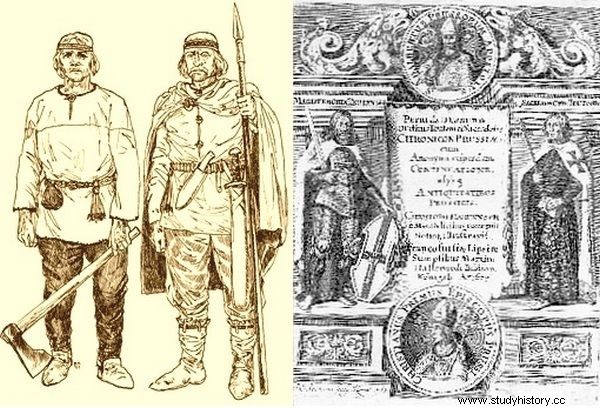
The negative image of the Prusai created by Peter of Dusburg was of interest to both Polish princes and the Teutonic Knights. In the picture on the left, Prussian warriors, on the right - the title page of the "Chronicles of Prussian lands" from the 17th century.
Stalking and human sacrifice
The missionary action in Prussia intensified at the beginning of the 13th century. At the same time, the invasions on these lands gained the rank of a crusade. Polish princes began expeditions to the areas of today's Warmia and Mazury, which resulted in the Prussian invasions in retaliation. This served as another excuse, this time for the Teutonic Knights, to use drastic methods of combat. The Prussians did not remain indebted.
Some episodes of the Teutonic-Prussian war are therefore extremely bloody, like scenes from the movies gore . The description of one of the captured Teutonic Knights being tortured in 1249 has survived:
The Prusai tied his hands alive to a tree and cut his belly button out of his belly, to which his intestines were attached, and then nailed them to the tree . When they did so with many blows, they forced him to run around the tree until his intestines were stuck to the trunk.
Peter of Dusburg assured the readers of his chronicle on this occasion:"Flip through and flip through all the martyrdom writings, and you will not find this kind of martyrdom in them."
When the Prussians managed to win, they sacrificed the leaders of the hostile armies to their gods. If there was no such prisoner among the prisoners (because he died or escaped), the unfortunate man was randomly selected. Exceptionally unlucky was a certain Hitzhals, a burgher from Magdeburg, who was captured in 1261 in the Battle of Pokarwis.
However, he knew from the old days the commander of the Prussian army, Henryk Monte, who grew up in Germany. The leader, for the sake of his former acquaintance, ordered the drawing to be repeated, but it was Hitzhals again. When a third attempt was made and the Magdeburg burgher turned out to be the "chosen one" for the third time, the resigned one did not protest any more. He was tied to a horse and burned alive .
However, the spiral of violence was spun by the Teutonic Knights who - as the chronicles put it - wanted to impose on Prusia the "yoke of the Christian faith", and at the same time make them a free labor force. There are accounts that after the capture of the Prussian settlements, "they captured and murdered all the inhabitants". Just. Another time, they gouged out the eyes of Prussian hostages.
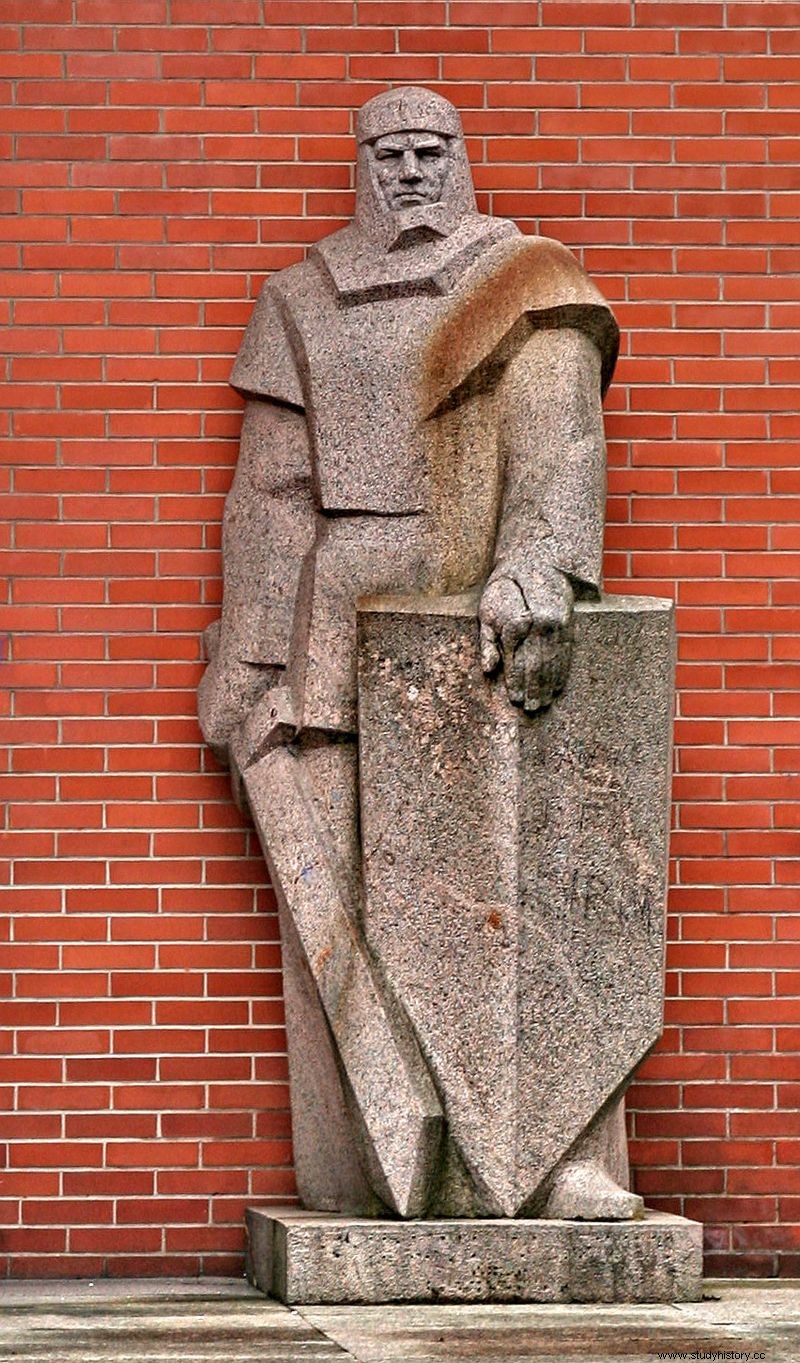
Herkus (Henryk) Monte was the leader of the Prussian tribe of Natangs in the years 1260-1274. In his youth, he was taken from his parents and taken by the Teutonic Knights to Magdeburg. Years later he returned to his Prussian homeland to fight for the removal of monks from it.
During the battles fought by monks-knights with Prussia, which lasted from 1230 to 1283, the technological advantage was definitely on the side of the former. The Prusai did not know, for example, crossbows, which resulted in a macabre episode. Once upon a time, the Teutonic crossbowman, fleeing from enemies, gave up his drawn weapon….
This crossbow was picked up by a Samb [the Sambians were one of the Prussian tribes] and hung around his neck. The others surrounded him in a circle and were amazed at what, because they had not seen such a thing before, and touched it with their hands in various places, until finally someone pressed and released the trigger and the bowstring of the crossbow and cut his neck with it, so that after a short while in time he gave up his ghost. After this event, the Prusai were very afraid of crossbows.
War, however, is an extreme situation. Do we know how these pagans behaved on a daily basis?
Drinking until you drop
The Prussians are one of the most mysterious peoples inhabiting medieval Europe. Their lands covered about 42,000 km 2 . It is estimated that in the 13th century, before the Teutonic invasion, the Prussian tribes numbered about 170,000 people. Polish kings and dukes tried to subdue them, but usually with little success. The invasions aroused the desire to retaliate, hence the Polish-Prussian border was more than once a place of bloody fights.
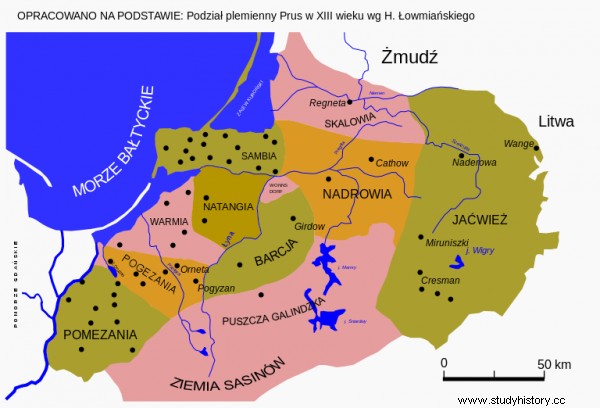
The name of the land, Prussia, was derived from the name of the people. In the thirteenth century, their territory was about 42 thousand. km². Apart from the Prusai, the Yotvingians are mentioned as a separate people.
It doesn't mean it's always been this way. Poles and Prussians traded with each other. There was even a suggestion that Mieszko I's mother might have come from Prussian lands (you can learn about who the mother of the first Polish ruler was HERE). Evidence of close contacts between former neighbors are numerous borrowings from Polish in the Prussian vocabulary. According to the Polish researcher and archaeologist, prof. Łucja Okulicz-Kozaryn:
Of (...) about 1800 Prussian words known, as many as 200, i.e. about 11%, can be derived directly from the Polish language or treated as Prussian derivatives of Polish words.
If in the 11th or 12th century a trip to Prussia was to go, its inhabitants would make a rather good impression (unless we tried to convert them to Christianity). They were extremely hospitable - and some elements of their feasts seem strangely familiar. Here is what Peter of Dusburg writes:
They show all kindness to their guests, and there is no food and drink in their home that they would not share with them. And they did not think they cared for their guests properly unless they consumed their drink to the point of drunkenness .
The guest had to drink as much as the host. As a result, all the revelers were drunk. Coming from other lands, it was also striking that there were no hungry beggars in Prussia. The poor could go home and eat with their hosts without any problems. Prussian customs were also praised by the shipwrecked, who were usually robbed without any scruples. But not there - the Prusai almost always helped them.
Childkillers
However, this is where the praise of the chroniclers of the neighboring countries is exhausted. According to Peter of Dusburg, the Prussian tribe of Galindians, convinced that they had too little land at their disposal to feed them all, decided to murder newborn girls. When their mothers protested, it was threatened that the disobedient would have their breasts cut .
It is not known to what extent the account of the Teutonic chronicler is based on facts, but something about the killing of children must have been the case. In 1218, Pope Honorius III issued two bulls in which he called for the collection of contributions for the redemption of Prussian girls to be killed.
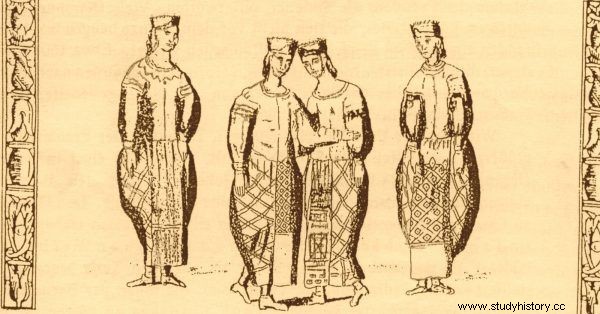
The fate of Prussian women was unenviable, even if only facts were taken into account and rumors were dismissed. The illustration shows the dancing Prussian women.
The very situation of women in Prussia was not the best. "The number of wives with them was not limited, as whoever could buy them had that much" - wrote this time Polish chronicler, Jan Długosz. In turn, Piotr of Dusburg, quoted more than once, noted that “the husband treats his wife as a servant; she does not eat with him at the table and washes the feet of the household and guests every day ”.
According to some reports, after her husband's death, the woman was burned along with his body, according to others - the son "inherited" his wife from his father. Researchers dealing with Prussia, including prof. Łucja Okulicz-Kozaryn, believe that only one spouse (the heir's mother) ended at the stake, and the rest fell to the heirs.
Prusai - our ancestors?
So the Prusai did not stand out in plus from the epoch nor in minus . In textbooks, they usually appear on three occasions:the murder of St. Wojciech, troublesome invasions of Poland, fights with the Teutonic Order. Meanwhile, in a sense, the Prussian tribes, despite linguistic differences, should be close to us. Many Prusai in the times of "pre-Teutonic Knights" came to Poland as prisoners and had to live in the so-called POW settlements.
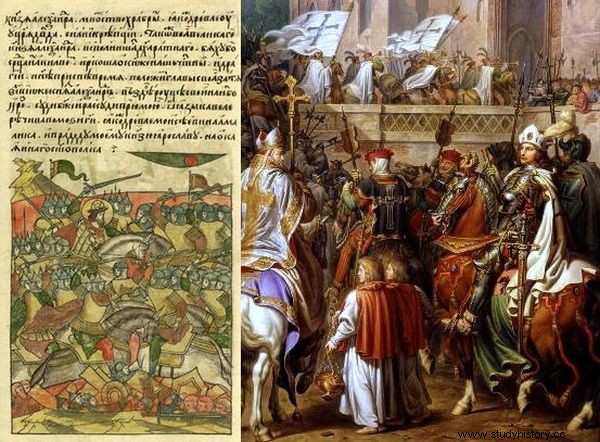
Under the guise of Christianization, the Teutonic Knights committed a real genocide. In the illustration on the left, a fragment of the chronicle describing the battle on Lake Pejpus, on the right - a painting by Karl Wilhelm Kolbe depicting the entry of the Grand Master to the Malbork Castle.
When the Teutonic Order consistently conquered Prussia, many of its inhabitants emigrated to Mazovia. It is enough to mention, for example, some families using the coat of arms of Prussia. Many inhabitants of today's Poland may therefore have Prussian roots.
